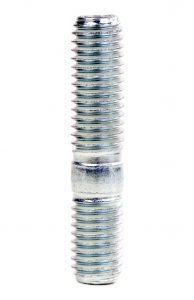
Also known simply as a stud, a threaded rod is a metal fastener — typically made of stainless steel — that’s characterized by the presence of threading on both ends. Depending on the specific type of threaded rod, the threading may extend just partially, or it may extend all the way. Regardless, all threaded rods feature threading on both ends, making it particularly useful in applications where tension is applied.
Threaded Rod vs Bolt: What’s the Difference?
Threaded rods are similar to bolts. They both feature a similar design consisting of a narrow fastener with threading. With that said, they aren’t necessarily the same. Bolts only have threading on one end, whereas threaded rods have threading on both ends. Furthermore, the end of the bolt without threading typically features a head, which is used to drive the head into the respective object or workpiece.
It’s also worth mentioning that most threaded rods, though not all, are longer than bolts. It’s not uncommon for threaded rods to be over 1 foot long. In comparison, bolts are typically just a few inches long.
Color Codes for Threaded Rods
When shopping for threaded rods, you may come across various color codes. Color codes for threaded rods are defined by the International Organization for Standardization (ISO). Threaded rods featuring a white color code are the strongest. The second-strongest color code is red, which is made of A4 stainless steel. The third-strongest color code for threaded fasteners is green, which is made of A2 stainless steel. Coming in fourth and five is yellow and unmarked, respectively.
What Are Threaded Rods Used For?
Threaded rods are used in a variety of applications, many of which pertain to manufacturing. Combustion gas engines, for example, often use threaded rods to secure the cylinder head to the engine block. Their dual-threading design allows them to withstand both tension and vibrations.
In addition to manufacturing, threaded rods are used extensively in the construction industry. When constructing buildings and bridges, for instance, construction companies often use threaded rods.
To recap, a threaded rod is a type of heavy-duty feaster that’s characterized by the presence of threading on both ends. In some threaded rods, the threading extends just partially on the ends. On others, it extends all the way. All threaded fasteners, however, have threading on both ends, which is in stark contrast to bolts, which typically only feature threading on one end.
